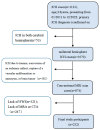Deep Medullary Vein and MRI Markers Were Related to Cerebral Hemorrhage Subtypes
- PMID: 37759916
- PMCID: PMC10526710
- DOI: 10.3390/brainsci13091315
Deep Medullary Vein and MRI Markers Were Related to Cerebral Hemorrhage Subtypes
Abstract
Background: To explore the performance of deep medullary vein (DMV) and magnetic resonance imaging (MRI) markers in different intracerebral hemorrhage (ICH) subtypes in patients with cerebral small vessel disease (CSVD).
Methods: In total, 232 cases of CSVD with ICH were included in this study. The clinical and image data were retrospectively analyzed. Patients were divided into hypertensive arteriopathy (HTNA)-related ICH, cerebral amyloid angiopathy (CAA)-related ICH, and mixed ICH groups. The DMV score was determined in the cerebral hemisphere contralateral to the ICH.
Results: The DMV score was different between the HTNA-related and mixed ICH groups (p < 0.01). The MRI markers and CSVD burden score were significant among the ICH groups (p < 0.05). Compared to mixed ICH, HTNA-related ICH diagnosis was associated with higher deep white matter hyperintensity (DWMH) (OR: 0.452, 95% CI: 0.253-0.809, p < 0.05) and high-degree perivascular space (PVS) (OR: 0.633, 95% CI: 0.416-0.963, p < 0.05), and CAA-related ICH diagnosis was associated with increased age (OR: 1.074; 95% CI: 1.028-1.122, p = 0.001). The DMV score correlated with cerebral microbleed (CMB), PVS, DWMH, periventricular white matter hyperintensity (PWMH), and CSVD burden score (p < 0.05) but not with lacuna (p > 0.05). Age was an independent risk factor for the severity of DMV score (OR: 1.052; 95% CI: 0.026-0.076, p < 0.001).
Conclusion: DMV scores, CSVD markers, and CSVD burden scores were associated with different subtypes of ICH. In addition, DMV scores were associated with the severity of CSVD and CSVD markers.
Keywords: MRI markers; cerebral small vessel disease; deep medullary vein; intracerebral hemorrhage.
Conflict of interest statement
The authors declare no conflict of interest.
Figures



Similar articles
-
Deep medullary vein damage correlates with small vessel disease in small vessel occlusion acute ischemic stroke.Eur Radiol. 2024 Sep;34(9):6026-6035. doi: 10.1007/s00330-024-10628-4. Epub 2024 Feb 10. Eur Radiol. 2024. PMID: 38337069 Free PMC article.
-
Contribution of Racial and Ethnic Differences in Cerebral Small Vessel Disease Subtype and Burden to Risk of Cerebral Hemorrhage Recurrence.Neurology. 2021 May 18;96(20):e2469-e2480. doi: 10.1212/WNL.0000000000011932. Epub 2021 Apr 21. Neurology. 2021. PMID: 33883240 Free PMC article.
-
New Insights in Addressing Cerebral Small Vessel Disease: Association With the Deep Medullary Veins.Front Aging Neurosci. 2020 Dec 1;12:597799. doi: 10.3389/fnagi.2020.597799. eCollection 2020. Front Aging Neurosci. 2020. PMID: 33335483 Free PMC article.
-
Research Advancements on the Correlation Between Spontaneous Intracerebral Hemorrhage of Different Etiologies and Imaging Markers of Cerebral Small Vessel Disease.Neuropsychiatr Dis Treat. 2024 Feb 20;20:307-316. doi: 10.2147/NDT.S442334. eCollection 2024. Neuropsychiatr Dis Treat. 2024. PMID: 38405425 Free PMC article. Review.
-
Cortical superficial siderosis and recurrent intracerebral hemorrhage risk in cerebral amyloid angiopathy: Large prospective cohort and preliminary meta-analysis.Int J Stroke. 2019 Oct;14(7):723-733. doi: 10.1177/1747493019830065. Epub 2019 Feb 20. Int J Stroke. 2019. PMID: 30785378
References
-
- Pasi M., Sugita L., Xiong L., Charidimou A., Boulouis G., Pongpitakmetha T., Singh S., Kourkoulis C., Schwab K., Greenberg S.M., et al. Association of Cerebral Small Vessel Disease and Cognitive Decline After Intracerebral Hemorrhage. Neurology. 2021;96:e182–e192. doi: 10.1212/WNL.0000000000011050. - DOI - PMC - PubMed
-
- Baron J.C., Jensen-Kondering U., Sacco S., Posener S., Benzakoun J., Pallud J., Oppenheim C., Varlet P., Turc G. Can novel CT-and MR-based neuroimaging biomarkers further improve the etiological diagnosis of lobar intra-cerebral hemorrhage? J. Neurol. 2023;270:582–588. doi: 10.1007/s00415-022-11434-y. - DOI - PubMed
LinkOut - more resources
Full Text Sources
Research Materials

